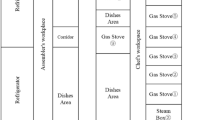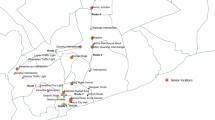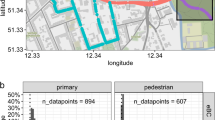Abstract
Ultrafine particles (UFPs) have been associated with negative effects on human health. Emissions from motor vehicles are the principal source of UFPs in urban air. A study in Vancouver suggested that UFP concentrations were related to density of fast food restaurants near the monitoring sites. A previous monitoring campaign could not separate the contribution of restaurants from road traffic. The main goal of this study has been the quantification of fast food restaurants' contribution to outdoor UFP concentrations. A portable particle number counter (DiscMini) has been used to carry out mobile monitoring in a largely pedestrianized area in the city center of Utrecht. A fixed route passing 17 fast food restaurants was followed on 8 days. UFP concentrations in front of the restaurants were 1.61 times higher than in a nearby square without any local sources used as control area and 1.22 times higher compared with all measurements conducted in between the restaurants. Adjustment for other sources such as passing mopeds, smokers or candles did not explain the increase. In conclusion, fast food restaurants result in significant increases in outdoor UFP concentrations in front of the restaurant.
This is a preview of subscription content, access via your institution
Access options
Subscribe to this journal
Receive 6 print issues and online access
$259.00 per year
only $43.17 per issue
Buy this article
- Purchase on Springer Link
- Instant access to full article PDF
Prices may be subject to local taxes which are calculated during checkout




Similar content being viewed by others
References
HEI Review Panel. Understanding the Health Effects of Ambient Ultrafine Particles. HEI perspectives 3. Health Effects Institute: Boston, Massachusetts. 2013.
Kumar S, Verma MK, Srivastava AK . Ultrafine particles in urban ambient air and their health perspectives. Rev Environ Health 2013; 28: 117–128.
Kumar P, Morawska L, Birmili W, Paasonen P, Hu M, Kulmala M et al. Ultrafine particles in cities. Environ Int 2014; 66: 1–10.
Morawska L, Ristovski Z, Jayaratne ER, Keogh DU, Ling X . Ambient nano and ultrafine particles from motor vehicle emissions: Characteristics, ambient processing and implications on human exposure. Atmos Environ 2008; 42: 8113–8138.
Wilson N, Parry R, Jalali J, Jalali R, McLean L, McKay O . High air pollution levels in some takeaway food outlets and barbecue restaurants. Pilot study in Wellington City, New Zealand. N Z Med J 2011; 124: 81–86.
Chen Y, Ho KF, Ho SS, Ho WK, Lee SC, Yu JZ et al. Gaseous and particulate polycyclic aromatic hydrocarbons (PAHs) emissions from commercial restaurants in Hong Kong. J Environ Monit 2007; 9: 1402–1409.
Daly BJ, Schmid K, Riediker M . Contribution of fine particulate matter sources to indoor exposure in bars, restaurants, and cafes. Indoor Air 2010; 20: 204–212.
Neuberger M, Moshammer H, Schietz A . Exposure to ultrafine particles in hospitality venues with partial smoking bans. J Expo Sci Environ Epidemiol 2013; 23: 519–524.
Wallace L, Ott W . Personal exposure to ultrafine particles. J Expo Sci Environ Epidemiol 2011; 21: 20–30.
Abernethy RC, Allen RW, McKendry IG, Brauer M . A land use regression model for ultrafine particles in Vancouver, Canada. Environ Sci Technol 2013; 47: 5217–5225.
Fierz M, Houle C, Steigmeier P, Burtscher H . Design, calibration, and field performance of a miniature diffusion size classifier. Aerosol Sci Technol 2011; 45: 1–10.
Klompmaker JO, Montagne DR, Meliefste K, Hoek G, Brunekreef B . Spatial variation of ultrafine particles and black carbon in two cities: results from a mobile measurement campaign. Sci Total Environ 2015; 508: 266–275.
Boogaard H, Montagne DR, Brandenburg AP, Meliefste K, Hoek G . Comparison of short-term exposure to particle number, PM10 and soot concentrations on three (sub) urban locations. Sci Total Environ 2010; 408: 4403–4411.
Boogaard H, Kos GPA, Weijers EP, Janssen NAH, Fischer PH, van der Zee SC et al. Contrast in air pollution components between major streets and background locations: particulate matter mass, black carbon, elemental composition, nitrogen oxide and ultrafine particle number. Atmos Environ 2011; 45: 50–658.
Boogaard H, Borgman F, Kamminga J, Hoek G . Exposure to ultrafine and fine particles and noise during cycling and driving in 11 Dutch cities. Atmos Environ 2009; 43: 4234–4242.
Deffner V, Küchenhoff H, Maier V, Pitz M, Cyrys J, Breitner S, Schneider A et al. Personal exposure to ultrafine particles: two-level statistical modeling of background exposure and time-activity patterns during three seasons. J Expo Sci Environ Epidemiol 2014 (doi:10.1038/jes.2014.73; e-pub ahead of print).
Sureda X, Fernández E, López MJ, Nebot M . Secondhand tobacco smoke exposure in open and semi-open settings: a systematic review. Environ Health Perspect 2013; 121: 766–773.
Hwang J, Lee K . Determination of outdoor tobacco smoke exposure by distance from a smoking source. Nicotine Tob Res 2014; 16: 478–484.
Gu J, Kraus U, Schneider A, Hampel R, Pitz M, Breitner S et al. Personal day-time exposure to ultrafine particles in different microenvironments. Int J Hyg Environ Health 2015; 218: 188–195.
He C, Morawska L, Hitchins J, Gilbert D . Contribution from indoor sources to particle number and mass concentrations in residential houses. Atmos Environ 2004; 38: 3405–3415.
Anderson PJ, Wilson JD, Hiller FC . Particle size distribution of mainstream tobacco and marijuana smoke. Analysis using the electrical aerosol analyzer. Am Rev Respir Dis 1989; 140: 202–205.
Acknowledgements
The study was supported by a grant from the Healthy Urban Living program of Utrecht University.
Author information
Authors and Affiliations
Corresponding author
Ethics declarations
Competing interests
The authors declare no conflict of interest.
Rights and permissions
About this article
Cite this article
Vert, C., Meliefste, K. & Hoek, G. Outdoor ultrafine particle concentrations in front of fast food restaurants. J Expo Sci Environ Epidemiol 26, 35–41 (2016). https://doi.org/10.1038/jes.2015.64
Received:
Revised:
Accepted:
Published:
Issue Date:
DOI: https://doi.org/10.1038/jes.2015.64
Keywords
This article is cited by
-
Spatial variations in urban air pollution: impacts of diesel bus traffic and restaurant cooking at small scales
Air Quality, Atmosphere & Health (2021)



